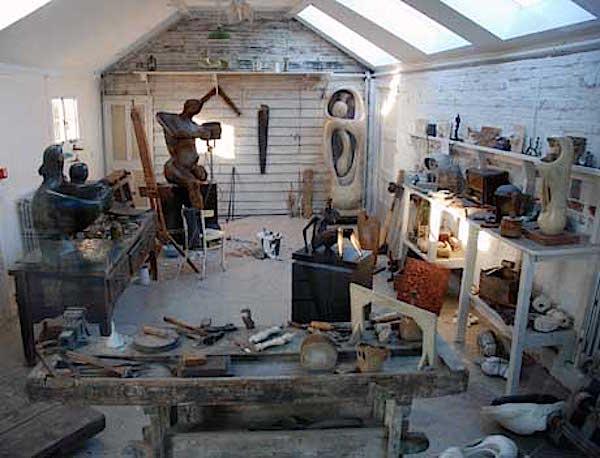Henry Moore’s famous maquette studio will be recreated in a special exhibition curated by the Director of The Henry Moore Foundation, Richard Calvocoressi at Gagosian Gallery in Davies Street, London. Henry Moore: Wunderkammer – Origin of Forms, will run from 9 February – 2 April 2015.
Henry Moore is best known for his large-scale sculptures that occupy public spaces across the world, however the starting-point for these works often came from small pieces of stone, shells, bones, animal skulls and other found objects that the artist collected and displayed in his studio at Perry Green, which is now home to The Henry Moore Foundation. These natural objects inspired the organic shapes in Moore’s sculptures, and he frequently cast them into plaster without any further intervention as the first step in his creation of a new work.
Moore’s “Wunderkammer” of found natural ephemera will be exhibited alongside the drawings and sculptural maquettes that they inspired, highlighting the progression of his work from its very origin to his finished bronzes.
To complement the exhibition, two monumental works, Relief No. 1 (1959) and Upright Motive No. 9 (1979) will be installed in Berkeley Square, Mayfair, from February 9–May 29, 2015. Both works grew out of the maquettes Moore made in 1955 for his brick Wall Relief, commissioned by the Bouwcentrum in Rotterdam, four of which will be included in the Gagosian show.
The exhibition is accompanied by a fully illustrated catalogue with a new essay by Richard Calvocoressi, and his discussion about Moore’s Wunderkammer with artist Edmund de Waal.
Henry Moore was born in Yorkshire, England in 1898 and died in Hertfordshire, England in 1986. His first solo exhibition was held in London in 1928; by the late 1940s he had become one of Britain’s most celebrated artists with a diverse artistic output that encompassed drawings, graphics, textiles, and sculpture. In the following decades he continued to receive increasingly significant sculpture commissions, following a major retrospective at the Museum of Modern Art in New York in 1946 and after winning the International Sculpture Prize at the Venice Biennale in 1948. His heightened success and fame provided him with the means to work increasingly in bronze rather than direct carving, thus achieving the monumental scale and freedom of form invention that he had always desired for his work. His public commissions occupy university campuses, pastoral expanses, and major urban centers in 38 countries around the world. His sculpture and drawings have been the subject of many museum exhibitions and retrospectives, including Tate Gallery, London (1951, 1968); Whitechapel Gallery, London (1960); Forte di Belvedere, Florence (1972); Tate Gallery and Serpentine Gallery, London, on the occasion of Moore’s eightieth birthday (1978); Metropolitan Museum of Art, New York (1983); Yorkshire Sculpture Park, Wakefield (1987); Royal Academy of Arts (1988); Shanghai Art Museum (2001); National Gallery of Art, Washington, D.C. (2001); Caixa Forum, Barcelona (2006); Kunsthal, Rotterdam (2006); Royal Botanical Gardens, Kew (2007–08); Didrichsen Museum, Helsinki (2008); Tate Britain, London (2010); and Kremlin Museums, Moscow (2012).
The Henry Moore Foundation was founded by Moore in 1977 to increase public enjoyment of the arts, especially sculpture. Today it opens his restored Hertfordshire home, studios, and sculpture grounds to the public, tours the world’s largest collection of his work, and maintains a center for the study of sculpture at the Henry Moore Institute in Leeds. The Foundation also supports sculpture through an active grants program. In 2012, Henry Moore Friends was launched to help promote his legacy. www.henry-moore.org.
Henry Moore’s Maquette Studio To Be Recreated For London Exhibition

